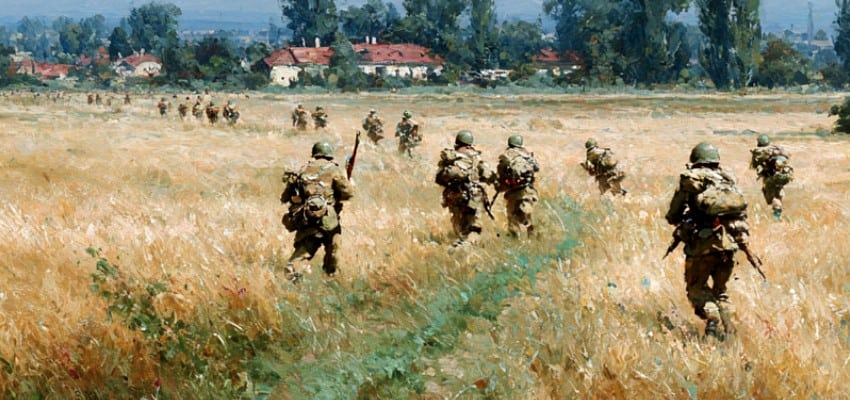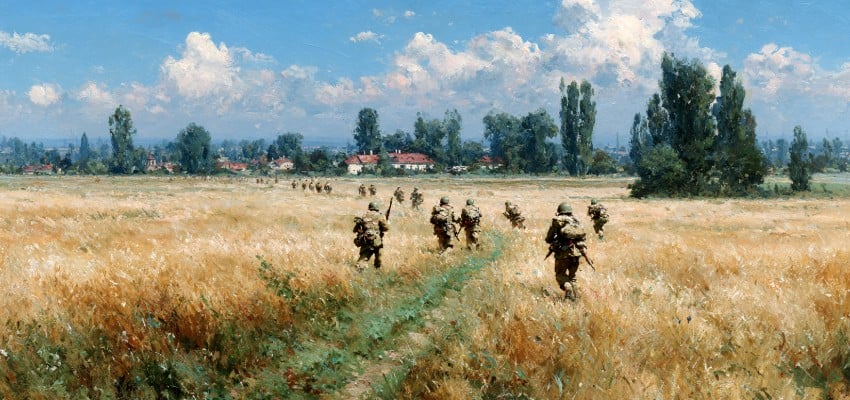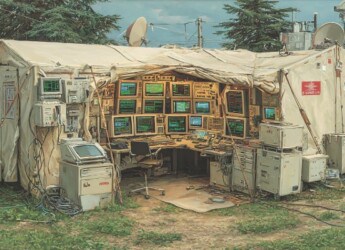Editor’s Note: As headlines briefly turned to diplomacy during the Alaska Summit on August 15, 2025, a more sobering reality unfolded beneath the surface: Russia appears to have used the moment not to pivot toward peace, but to mask a renewed military escalation. Drawing on battlefield developments and analytical insights from the Institute for the Study of War (ISW), this article examines the resurgence of maskirovka—Russia’s long-standing doctrine of strategic deception—as a deliberate tool in its evolving campaign.
For cybersecurity, information governance, and eDiscovery professionals, these developments highlight the growing intersection of deception, technology, and asymmetric operations in modern conflict. From institutional shifts in military doctrine to battlefield reliance on drones and dispersed mobility, the Kremlin’s recalibration carries broad strategic implications. Just as critical, however, are the documented war crimes—extrajudicial killings and systemic brutality—that continue to emerge, underscoring the human cost of Russia’s campaign and the moral complexity of a war increasingly defined by impunity as much as innovation.
Content Assessment: Maskirovka Returns: Russia’s Strategic Recalibration for War
Information - 94%
Insight - 93%
Relevance - 93%
Objectivity - 94%
Authority - 95%
94%
Excellent
A short percentage-based assessment of the qualitative benefit expressed as a percentage of positive reception of the recent article from ComplexDiscovery OÜ titled, "Maskirovka Returns: Russia’s Strategic Recalibration for War."
Background Note: ComplexDiscovery’s staff offers distinctive perspectives on the Russo-Ukrainian war and Middle Eastern conflicts, informed by their military experience on the West German, East German, and Czechoslovakian borders during the Cold War, as well as in Sinai as part of Camp David Accord compliance activities, during the timeframe of the Persian Gulf War. This firsthand regional knowledge has been further enhanced by recent staff travels to Eastern European countries, including Estonia, Finland, Latvia, Lithuania, and Poland. These visits have provided up-to-date, on-the-ground insights into the current geopolitical climate in regions directly impacted by the ongoing conflict.
Combined with cybersecurity, information governance, and eDiscovery proficiency, this multifaceted experience enables comprehensive analysis of these conflicts, including the critical impact of cyber warfare, disinformation, and digital forensics on modern military engagements. This unique background positions ComplexDiscovery to provide valuable insights for conflict-related investigations and litigation, where understanding the interplay of technology, data, and geopolitical factors is crucial.
Russo-Ukrainian Conflict Update*
Maskirovka Returns: Russia’s Strategic Recalibration for War
ComplexDiscovery Staff
As global attention turned briefly to diplomacy with the Alaska Summit on August 15, 2025, a parallel narrative emerged—one not of peace, but of calculation. Ukrainian intelligence suggested that Russia used the diplomatic event not to de-escalate, but to delay—buying time to rearm, reposition, and refine its strategic calculus for a large-scale offensive in the fall. The Kremlin’s intent, never far removed from its maximalist war aims, is now being reinforced by signs of intensified military preparation across multiple fronts, suggesting that Russia is recalibrating not only tactically but institutionally.
This alleged use of diplomatic overture as operational masking is not without precedent. Soviet-era doctrine often emphasized “maskirovka”—the strategic use of deception to conceal intentions. What appears to be unfolding now is a modern version of that doctrine, as Russian forces reportedly transferred tens of thousands of troops to the Zaporizhia, Pokrovsk, and Novopavlivka directions. Simultaneously, Russia accelerated its procurement of drones and missiles, later employed in mass strikes that killed civilians in Kyiv and elsewhere between August 27 and 28.
Meanwhile, Defense Minister Andrei Belousov delivered a sweeping speech to the Russian Ministry of Defense on August 29, presenting an institutional vision for Russia’s evolving warfighting model. He touted gains of 600–700 square kilometers per month—a claim sharply out of line with independent assessments, which recorded only around 500 square kilometers gained in August, largely in open or lightly fortified terrain. What these figures obscure is the cost: Russian forces are incurring nearly 1,000 personnel casualties daily, often in infantry-led assaults that suggest continued reliance on attritional tactics rather than maneuver warfare.
Yet Belousov’s remarks were more revealing in what they suggested about Russian adaptation. The Kremlin appears to be phasing out heavy armor in favor of light mobility platforms—motorcycles, all-terrain vehicles, and buggies—purchased in large quantities from Chinese suppliers. This shift acknowledges a battlefield shaped increasingly by drone warfare, where heavy platforms become liabilities under constant aerial surveillance and precision strikes. These changes mark not merely a logistical adjustment, but a doctrinal shift toward mobility, dispersion, and improvisation—a belated recognition of lessons Ukraine has exploited since 2023.
The development of Russia’s Unmanned Systems Forces also reveals a push to institutionalize previously ad hoc drone units. Belousov admitted, however, that these units remain plagued by inadequate logistics, training, and staffing. This imbalance between technological ambition and bureaucratic capacity has long characterized the Russian defense establishment and raises questions about whether these changes will yield effective force multipliers—or simply more bottlenecks.
Against this backdrop, Ukraine’s asymmetric strategy continues to expand in ambition and reach. Ukrainian forces struck deep into Russian territory in late August, hitting a critical S-400 radar in Crimea, sabotaging fuel trains in Tver, and damaging the Kuibyshev Oil Refinery in Samara Oblast with a 28-drone attack. These strikes do more than destroy infrastructure—they erode the logistical sinews of Russia’s war effort and send a signal to Moscow: the interior is no longer a sanctuary.
Fuel shortages in Russia are becoming increasingly difficult to contain. With key facilities like the Ust-Luga port in Leningrad Oblast forced to operate at half capacity, domestic gasoline supplies are under acute pressure. Transport bottlenecks, particularly those linked to railway logistics, are compounding the crisis, with deliveries delayed by months. Inflationary pressures may soon test the Kremlin’s ability to maintain both economic stability and public patience in the face of a war that is visibly stretching Russia’s internal capacity.
In contrast to Moscow’s preparations for escalation, Kyiv continues to signal readiness for peace. High-level meetings in New York City between Ukrainian and U.S. officials reaffirmed Ukraine’s willingness to engage in direct negotiations with Russia—even at the level of heads of state. This messaging, while consistent with Kyiv’s public diplomacy, also highlights a strategic duality: diplomatic openness alongside relentless military pressure.
On the battlefield, key tactical movements reflect both the resilience and the limitations of Russian advances. Russia has claimed limited progress near Borova and Pokrovsk, including the capture of Leontovychi, while attacks in Chasiv Yar, Kupyansk, and Lyman yielded little confirmed territory. Ukrainian forces have recaptured ground in northern Kharkiv and continue to repel mechanized assaults, particularly around Orikhiv in Zaporizhia. Notably, Russian forces continue to use small units, including single-soldier reconnaissance teams and drone operators, to probe and weaken Ukrainian lines—tactics reflecting low trust in large-unit maneuver and a reliance on precision at the micro-tactical level.
Perhaps most chilling, however, are the reports of war crimes that continue to emerge. The execution of seven Ukrainian prisoners of war near Myrolyubivka in Donetsk Oblast is not an isolated event but part of a growing pattern of extrajudicial killings by Russian units. The survivor’s account—written by hand due to injuries that left him unable to speak—is a grim reminder of the moral terrain on which this war is fought. These actions not only violate the Geneva Conventions but point to a permissive command environment where atrocities are tolerated, if not encouraged.
Western support continues to underwrite Ukraine’s defense posture. The U.S. approved over $1.1 billion in new Foreign Military Sales, including advanced ERAM missiles, Starlink terminal support, and maintenance for Patriot air defense systems. These provisions bolster Ukraine’s layered defense architecture at a time when Russian drone and missile strikes are expected to intensify ahead of the anticipated autumn offensive.
As August closes, the war’s strategic complexion is defined not just by the lines on the map but by the adaptations each side is making. Russia is trying to retool its force, reframe its economy, and reassert its offensive initiative. Ukraine, meanwhile, is evolving the art of asymmetric disruption—reaching deeper into Russian territory and applying pressure across logistical, political, and economic fronts.
Ultimately, this phase of the war raises a critical question: can Russia’s adaptations in light mobility and drone warfare overcome the structural weaknesses of its command, economy, and public will—or will Ukraine’s ability to target depth, disrupt infrastructure, and shape the information domain prove decisive in a war now being fought as much in the rear as on the front?
Detailed Reporting with Maps for August 29, 2025, from the ISW – Mouseover to Scroll
Russo-Ukrainian War August 29 2025 - UpdateReview the Detailed Reporting and Maps PDF
About the Institute for the Study of War Research Methodology
ISW’s research methodology relies on both primary and secondary sources, enabling researchers to develop a comprehensive understanding of the situation on the ground. In order to analyze military and political developments in any given area, ISW’s research analysts must wholly understand the systems of enemy and friendly forces. They must also understand the population demographics, physical terrain, politics, and history of that area. This lays the analytical foundation for understanding the reasons for particular developments and fulfilling their assigned research objectives. ISW analysts also spend time in places like Iraq, Afghanistan, and elsewhere in order to gain a better understanding of the security and political situation and to evaluate the implementation of current strategies and policies. Their researchers compile data and analyze trends, producing a granular analysis of developments in areas of research, producing an accurate, high-resolution, timely, and thorough picture of the situation. ISW’s research methodology guarantees its success and commitment to improving the nation’s ability to execute military operations, achieve strategic objectives, and respond to emerging problems that may require the use of American military power.
About the Institute for the Study of War
The Institute for the Study of War advances an informed understanding of military affairs through reliable research, trusted analysis, and innovative education. They are committed to improving the nation’s ability to execute military operations and respond to emerging threats in order to achieve U.S. strategic objectives. ISW is a non-partisan, non-profit, public policy research organization.
Learn more, get involved, and contribute today.
Assisted by GAI and LLM Technologies
* Sourced and shared with permission from the Institute for the Study of War (ISW).
Additional Reading
- From Dissent to OSINT? Understanding, Influencing, and Protecting Roles, Reputation, and Revenue
- Data Embassies: Sovereignty, Security, and Continuity for Nation-States
Source: ComplexDiscovery OÜ



























